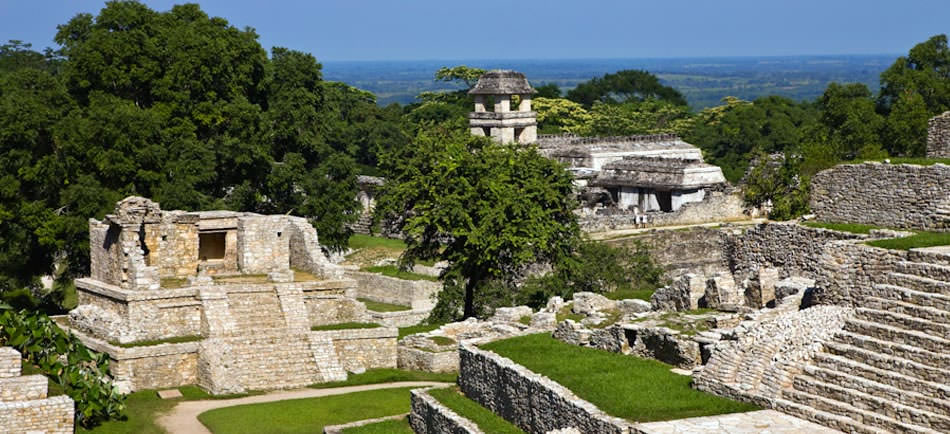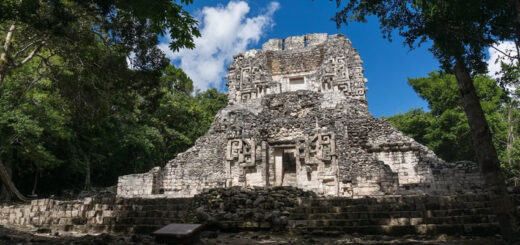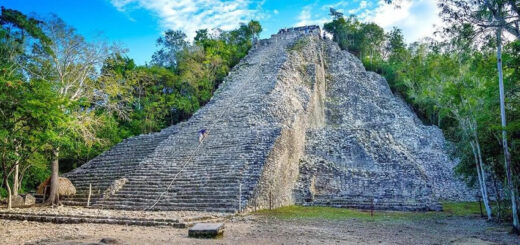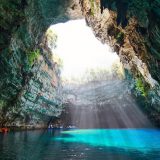
Palenque
Palenque is in Chiapas, Mexico famous for the ruins of a Mayan city dating from about 600 AD to 800 AD. Set amidst thick trees, Palenque still evokes some of the wonder that the early Spanish visitors must have felt when they first came across the ruins.
Palenque is actually a medium-sized archaeological site, much smaller than the huge sites like Tikal or else Copán, but it contains a few of the finest sculpture, architecture, roof comb as well as bas-relief carvings of the Mayan era.
Palenque in Yucatec Maya “Bàak”, also anciently known as Lakamha (literally: “Big Water”), was a Maya city state in southern Mexico that flourished in the 7th century. The Palenque ruins date from ca. 226 BC to ca. AD 799.After its decline, it was absorbed into the jungle of cedar, mahogany, and sapodilla trees, but has since been excavated and restored and is now a famous archaeological site attracting thousands of visitors. It is located near the Usumacinta River in the Mexican state of Chiapas, about 130 km (81 mi) south of Ciudad del Carmen,[citation needed] 150 m (164 yd) above sea level. It averages a humid 26 °C (79 °F) with roughly 2160 mm (85 in) of rain a year.
Palenque is a medium-sized site, much smaller than such huge sites as Tikal, Chichen Itza, or Copán, but it contains some of the finest architecture, sculpture, roof comb and bas-relief carvings that the Mayas produced. Much of the history of Palenque has been reconstructed from reading the hieroglyphic inscriptions on the many monuments; historians now have a long sequence of the ruling dynasty of Palenque in the 5th century and extensive knowledge of the city-state’s rivalry with other states such as Calakmul and Toniná. The most famous ruler of Palenque was K’inich Janaab Pakal, or Pacal the Great, whose tomb has been found and excavated in the Temple of the Inscriptions.
By 2005, the discovered area covered up to 2.5 km² (1 sq mi), but it is estimated that less than 10% of the total area of the city is explored, leaving more than a thousand structures still covered by jungle.
History
Mythological beings used a variety of emblem glyphs in their titles indeed suggests a complex early history. For instance, K’uk’ B’ahlam, the supposed founder of the Palenque dynasty, is called a Toktan Ajaw in the text of the Temple of the Foliated Cross.
The famous structures that we know today probably represent a rebuilding effort in response to the attacks by the city of Calakmul and its client states in 599 and 611. One of the main figures responsible for rebuilding Palenque and for a renaissance in the city’s art and architecture is also one of the best-known Maya Ajaw, K’inich Janaab’ Pakal (Pacal the Great), who ruled from 615 to 683. He is best known through his funerary monument, dubbed the Temple of Inscriptions after the lengthy text preserved in the temple’s superstructure. At the time Alberto Ruz Lhuillier excavated Pakal’s tomb it was the richest and best preserved of any scientifically excavated burial then known from the ancient Americas. It held this position until the discovery of the rich Moche burials at Sipan, Peru and the recent discoveries at Copan and Calakmul.
Beside the attention that K’inich Janaab’ Pakal’s tomb brought to Palenque, the city is historically significant for its extensive hieroglyphic corpus composed during the reigns of Janaab’ Pakal his son K’inich Kan B’ahlam and his grandson K’inich Akal Mo’ Naab’, and for being the location where Heinrich Berlin and later Linda Schele and Peter Mathews outlined the first dynastic list for any Maya city. The work of Tatiana Proskouriakoff as well as that of Berlin, Schele, Mathews, and others initiated the intense historical investigations that characterized much of the scholarship on the ancient Maya from the 1960s to the present. The extensive iconography and textual corpus has also allowed for study of Classic period Maya mythology and ritual practice.
Early Classic period
The first ajaw, or king, of B’aakal that we know of was K’uk Balam (Quetzal Jaguar), who governed for four years starting in the year 431. After him, a king came to power, nicknamed Casper by archaeologists. The next two kings were probably Casper’s sons. Little was known about the first of these, B’utz Aj Sak Chiik, until 1994, when a tablet was found describing a ritual for the king. The first tablet mentioned his successor Ahkal Mo’ Naab I as a teenage prince, and therefore it is believed that there was a family relation between them. For unknown reasons, Akhal Mo’ Naab I had great prestige, so the kings who succeeded him were proud to be his descendants.
When Ahkal Mo’ Naab I died in 524, there was an interregnum of four years, before the following king was crowned en Toktán in 529. K’an Joy Chitam I governed for 36 years. His sons Ahkal Mo’ Naab II and K’an B’alam I were the first kings who used the title Kinich, which means “the great sun”. This word was used also by later kings. B’alam was succeeded in 583 by Yohl Ik’nal, who was supposedly his daughter. The inscriptions found in Palenque document a battle that occurred under her government in which troops from Calakmul invaded and sacked Palenque, a military feat without known precedents. These events took place in 599.
A second victory by Calakmul occurred some twelve years later, in 611, under the government of Aj Ne’ Yohl Mat, son of Yohl Iknal. In this occasion, the king of Calakmul entered Palenque in person, consolidating a significant military disaster, which was followed by an epoch of political disorder. Aj Ne’ Yohl Mat was to die in 612.
Late Classic period
B’aakal began the Late Classic period in the throes of the disorder created by the defeats before Calakmul. The glyphic panels at the Temple of Inscriptions, which records the events at this time, relates that some fundamental annual religious ceremonies were not performed in 613, and at this point states: “Lost is the divine lady, lost is the king.” Mentions of the government at the time have not been found.
It is believed that after the death of Aj Ne’ Yohl Mat, Janaab Pakal, also called Pakal I, took power thanks to a political agreement. Janaab Pakal assumed the functions of the ajaw (king) but never was crowned. He was succeeded in 612 by his daughter, the queen Sak K’uk’, who governed for only three years until her son was old enough to rule. It is considered that the dynasty was reestablished from then on, so B’aakal retook the path of glory and splendor.
The grandson of Janaab Pakal is the most famous of the Mayan kings, K’inich Janaab’ Pakal, also known as Pakal the Great. He began rule at the age of 12 years after his mother Sak Kuk resigned as queen after three years, thus passing power on to him. Pakal the Great reigned in Palenque from 615 to 683, and his mother remained an important force for the first 25 years of his rule. She may have ruled jointly with him. Known as the favorite of the gods, he carried Palenque to new levels of splendor, in spite of having come to power when the city was at a low point. Pakal married the princess of Oktán, Lady Tzakbu Ajaw (also known as Ahpo-Hel) in 624 and had at least three children.
During his government, most of the palaces and temples of Palenque were constructed; the city flourished as never before, eclipsing Tikal. The central complex, known as The Palace, was enlarged and remodeled on various occasions, notably in the years 654, 661, and 668. In this structure, is a text describing how in that epoch Palenque was newly allied with Tikal, and also with Yaxchilan, and that they were able to capture the six enemy kings of the alliance. Not much more had been translated from the text.
After the death of Pakal in 683, his older son K’inich Kan B’alam assumed the kingship of B’aakal, who in turn was succeeded in 702 by his brother K’inich K’an Joy Chitam II. The first continued the architectural and sculptural works that were begun by his father, as well as finishing the construction of the famous tomb of Pakal. Pakal’s sarcophagus, built for a very tall man, held the richest collection of jade seen in a Mayan tomb. A jade mosaic mask was placed over his face, and a suit made of jade adorned his body, with each piece hand-carved and held together by gold wire.
Furthermore, K’inich Kan B’alam I began ambitious projects, like the Group of the Crosses. Thanks to numerous works begun during his government, now we have portraits of this king, found in various sculptures. His brother succeeded him continuing with the same enthusiasm of construction and art, reconstructing and enlarging the north side of the Palace. Thanks to the reign of these three kings, B’aakal had a century of growing and splendor.
In 711, Palenque was sacked by the realm of Toniná, and the old king K’inich K’an Joy Chitam II was taken prisoner. It is not known what the final destination of the king was, and it is presumed that he was executed in Toniná. For 10 years there was no king. Finally, K’inich Ahkal Mo’ Nab’ III was crowned in 722. Although the new king belonged to the royalty, there is no reason to be sure that he was the direct inheritor direct of K’inich K’an Joy Chitam II. It is believed, therefore, that this coronation was a break in the dynastic line, and probably K’inich Ahkal Nab’ arrived to power after years of maneuvering and forging political alliances. This king, his son, and grandson governed until the end of the 8th century. Little is known about this period, except that, among other events, the war with Toniná continued, where there are hieroglyphics that record a new defeat of Palenque.
Abandonment
During the 8th century, B’aakal came under increasing stress, in concert with most other Classic Mayan city-states, and there was no new elite construction in the ceremonial center sometime after 800. An agricultural population continued to live here for a few generations, then the site was abandoned and was slowly grown over by the forest. The district was very sparsely populated when the Spanish first arrived in the 1520s. Occasionally city-state lords were women. Lady Sak Kuk ruled at Palenque for at least three years starting in 612 CE, before she passed her title to her son. However, these female rulers were accorded male attributes. Thus, these women became more masculine as they assumed roles that were typically male roles.
Site structures
Temple of the Inscriptions
The Temple of Inscriptions had begun perhaps as early as 675 as the funerary monument of Hanab-Pakal. The temple superstructure houses the second longest glyphic text known from the Maya world (the longest is the Hieroglyphic Stairway at Copan). The Temple of the Inscriptions records approximately 180 years of the city’s history from the 4th through 12th K’atun. The focal point of the narrative records K’inich Janaab’ Pakal’s K’atun period-ending rituals focused on the icons of the city’s patron deities prosaically known collectively as the Palenque Triad or individually as GI, GII, and GIII.
The Pyramid measures 60 meters wide, 42.5 meters deep and 27.2 meters high. The Summit temple measures 25.5 meters wide, 10.5 meters deep and 11.4 meters high. The largest stones weigh 12 to 15 tons. These were on top of the Pyramid. The Total volume of pyramid and temple is 32,500 cu. meters.
In 1952 Alberto Ruz Lhuillier removed a stone slab in the floor of the back room of the temple superstructure to reveal a passageway (filled in shortly before the city’s abandonment and reopened by archeologists) leading through a long stairway to Pakal’s tomb. The tomb itself is remarkable for its large carved sarcophagus, the rich ornaments accompanying Pakal, and for the stucco sculpture decorating the walls of the tomb. Unique to Pakal’s tomb is the psychoduct, which leads from the tomb itself, up the stairway and through a hole in the stone covering the entrance to the burial. This psychoduct is perhaps a physical reference to concepts about the departure of the soul at the time of death in Maya eschatology where in the inscriptions the phrase ochb’ihaj sak ik’il (the white breath road-entered) is used to refer to the leaving of the soul. A find such as this is greatly important because it demonstrated for the first time the temple usage as being multifaceted. These pyramids were, for the first time, identified as temples and also funerary structures.
The much-discussed iconography of the sarcophagus lid depicts Pakal in the guise of one of the manifestations of the Maya Maize God emerging from the maws of the underworld.
The temple also has a duct structure that still is not completely understood by archaeologists. It has been suggested that the duct aligns with the winter solstice and that the sun shines down on Pakal’s tomb.
Temples of the Cross group
The Temple of the Cross, Temple of the Sun, and Temple of the Foliated Cross are a set of graceful temples atop step pyramids, each with an elaborately carved relief in the inner chamber depicting two figures presenting ritual objects and effigies to a central icon. Earlier interpretations had argued that the smaller figure was that of K’inich Janaab’ Pakal while the larger figure was K’inich Kan B’ahlam. However, it is now known based on a better understanding of the iconography and epigraphy that the central tablet depicts two images of Kan B’ahlam. The smaller figure shows K’inich Kan B’ahlam during a rite of passage ritual at the age of six (9.10.8.9.3 9 Akbal 6 Xul) while the larger is of his accession to kingship at the age of 48. These temples were named by early explorers; the cross-like images in two of the reliefs actually depict the tree of creation at the center of the world in Maya mythology.
Palace
The Palace, a complex of several connected and adjacent buildings and courtyards, was built by several generations on a wide artificial terrace during four century period. The Palace was used by the Mayan aristocracy for bureaucratic functions, entertainment, and ritualistic ceremonies. The Palace is located in the center of the ancient city.
Within the Palace there are numerous sculptures and bas-relief carvings that have been conserved. The Palace most unusual and recognizable feature is the four-story tower known as The Observation Tower. The Observation Tower like many other buildings at the site exhibit a mansard-like roof. The A-shaped Corbel arch is an architectural motif observed throughout the complex. The Corbel arches require a large amount of masonry mass and are limited to a small dimensional ratio of width to height providing the characteristic high ceilings and narrow passageways. The Palace was equipped with numerous large baths and saunas which were supplied with fresh water by an intricate water system. An aqueduct, constructed of great stone blocks with a three-meter-high vault, diverts the Otulum River to flow underneath the main plaza. The Palace is the largest building complex in Palenque measuring 97 meters by 73 meters at its base.
Other Notable Constructions
The Temple of the Skull has a skull on one of the pillars.
Temple XIII contained the Tomb of the Red Queen, an unknown noble woman, possibly the wife of Pakal, discovered in 1994. The remains in the sarcophagus were completely covered with a bright red powder made of cinnabar.
The Temple of The Jaguar (a.k.a. The Temple of the Beautiful Relief) at a distance of some 200 meters south of the main group of temples; its name came from the elaborate bas-relief carving of a king seated on a throne in the form of a jaguar.
Structure XII with a bas-relief carving of the God of Death.
Temple of the Count another elegant Classic Palenque temple, which got its name from the fact that early explorer Jean Frederic Waldeck lived in the building for some time, and Waldeck claimed to be a count.
The site also has a number of other temples, tombs, and elite residences, some a good distance from the center of the site, a court for playing the Mesoamerican Ballgame, and an interesting stone bridge over the Otulum River some distance below the Aqueduct.
Modern investigations
Palenque is perhaps the most studied and written about of Maya sites.
After de la Nada’s brief account of the ruins no attention was paid to them until 1773 when one Don Ramon de Ordoñez y Aguilar examined Palenque and sent a report to the Capitan General in Antigua Guatemala, a further examination was made in 1784 saying that the ruins were of particular interest, so two years later surveyor and architect Antonio Bernasconi was sent with a small military force under Colonel Antonio del Río to examine the site in more detail. Del Rio’s forces smashed through several walls to see what could be found, doing a fair amount of damage to the Palace, while Bernasconi made the first map of the site as well as drawing copies of a few of the bas-relief figures and sculptures. Draughtsman Luciano Castañeda made more drawings in 1807, and a book on Palenque, Descriptions of the Ruins of an Ancient City, discovered near Palenque, was published in London in 1822 based on the reports of those last two expeditions together with engravings based on Bernasconi and Castañedas drawings; two more publications in 1834 contained descriptions and drawings based on the same sources.
Juan Galindo visited Palenque in 1831, and filed a report with the Central American government. He was the first to note that the figures depicted in Palenque’s ancient art looked like the local Native Americans; some other early explorers, even years later, attributed the site to such distant peoples as Egyptians, Polynesians, or the Lost Tribes of Israel.
Starting in 1832 Jean Frederic Waldeck spent two years at Palenque making numerous drawings, but most of his work was not published until 1866. Meanwhile, the site was visited in 1840 first by Patrick Walker and Herbert Caddy on a mission from the governor of British Honduras, and then by John Lloyd Stephens and Frederick Catherwood who published an illustrated account the following year which was greatly superior to the previous accounts of the ruins.
Désiré Charnay took the first photographs of Palenque in 1858, and returned in 1881–1882. Alfred Maudslay encamped at the ruins in 1890–1891 and took extensive photographs of all the art and inscriptions he could find, and made paper and plaster molds of many of the inscriptions, and detailed maps and drawings, setting a high standard for all future investigators to follow. Maudslay learned the technique of making the papier mache molds of the sculptures from Frenchman Desire Charnay.
Several other expeditions visited the ruins before Frans Blom of Tulane University in 1923, who made superior maps of both the main site and various previously neglected outlying ruins and filed a report for the Mexican government on recommendations on work that could be done to preserve the ruins.
From 1949 through 1952 Alberto Ruz Lhuillier supervised excavations and consolidations of the site for Mexico’s National Institute of Anthropology and History (INAH); it was Ruz Lhuillier who was the first person to gaze upon Pacal the Great’s tomb in over a thousand years. Ruz worked for four years at the Temple of Inscriptions before unearthing the tomb. Further INAH work was done in lead by Jorge Acosta into the 1970s.
In 1973, the first of the very productive Palenque Mesa Redonda (Round table) conferences was held here on the inspiration of Merle Greene Robertson; thereafter every few years leading Mayanists would meet at Palenque to discuss and examine new findings in the field. Meanwhile, Robertson was conducting a detailed examination of all art at Palenque, including recording all the traces of color on the sculptures.
The 1970s also saw a small museum built at the site.
In the last 15 or 20 years, a great deal more of the site has been excavated, but currently, archaeologists estimate that only 5% of the total city has been uncovered
Palenque remains much visited, and perhaps evokes more affection in visitors than any other Mesoamerican ruin.
In 2010, Pennsylvania State University researchers, Christopher Duffy and Kirk French, identified the Piedras Bolas Aqueduct as a pressurised aqueduct, the earliest known in the New World. It is a spring-fed conduit located on steep terrain that has a restricted opening that would cause the water to exit forcefully, under pressure, to a height of 6 metres (20 ft). They were unable to identify the use for this man-made feature.
How to get there
By air
A new airport just opened in Palenque with direct flights from Mexico City with Interjet (~$150 USD each way) and Tuxtla Gutiérrez with Ka’an Air (~$115 USD each way). As of May 2014 there was no shuttle bus from the airport. The only option are fixed priced taxis – to city centre only 3km away (M$200) and to the ruins area about 7km away (M$250). The closest public bus from the airport is over 2km away.
The next closest airport is in Villahermosa is about 2.5 hours away by road. Tuxtla Gutiérrez, the airport for San Cristobal de las Casas is five to six hours away by bus. Both airports are well serviced with flights from Mexico City and other points in Mexico.
By road
The easiest way to get to Palenque is by bus. From the airport you can take a prepaid taxi to the bus station in town, which is 280 Pesos(August 2014)and it takes 30 minutes. There are two bus stations in town and both are just 2 minutes walk distance between them. There are many buses daily from San Cristobal de las Casas (five hours), Tuxtla Gutiérrez (six hours), Villahermosa (2.5 hours), Merida (8 hours), Campeche (5 hours), Cancun (13 hours). Daily (one or two buses) also ply from Mexico City (16 hours), Oaxaca (15 hours), Playa del Carmen (12 hours), and Tulum (12 hours).
Also if you would like to blend in with people and culture colectivos (Passenger Van) are the best way. Take a colectivo from Tuxtla Gutierrez bus station to San Cristobal de las Casas (2 hours/50 Pesos), then to Ocosingo (3 hours/65 Pesos) and finally from there to Palenque (3 hours/ 60 Pesos). You can stay overnight in any of these towns to continue your journey the next day. Taxis are really cheap around 20 Pesos to most of the hostels/Hotels. Colectivos start early in the morning mostly by 4am.
It is also possible to get to Palenque from Flores in Guatemala by bus (6h, leaving Flores daily at 5am, USD 35.00).
Get around
The ruins are about 6 km from the town of Palenque and colectivos run between the town and ruins every 10 to 15 minutes during the day. Cost is 20 pesos flat rate around the town. (September 2016) There are a number of visitors (both International and Mexican) who drive around, so hitchhiking is another option.
Other ruins in the general area are Yaxchilán and Bonampak. These can be arranged by day trip (650 pesos, december 2013) or overnighter (1,250 pesos, december 2013) with any agency in town.
Misol Ha and Agua Azul are famous waterfalls in the area. The town’s many tour agencies organize 7 hour combination trips to both falls for 130-150 pesos, excluding entrance fees (30 and 38 pesos respectively). (December 2013) The falls are just an hour or so outside town, but the tours are arranged so that there is time to swim and eat (at Agua Azul).
Entrance for Aqua Azul 40 pesos (2015, March)
For a visit to Roberto Barrios (entrance fee: 20$) you can take a colectivo from the local market in Palenque. The ride takes around 45 minutes for 50 Pesos. Alternatively, in El Panchan half-day tours are offered for 150$. They start at noon and offer enough time for a swim. Unless you want to stop in town for shopping you may consider it. (Nov’16)
Site and around
Spend a whole day exploring the site which spreads over 15 sq km. Only the central acropolis has been excavated. The Templo de Las Inscripciones, a burial monument, is the tallest building. El Palacio, the rulers’ residence, was built in stages from 400 AD to 900 AD and underwent restoration in 1955. There’s a 31 peso fee to enter the national park, and then another 65 peso for the ruin site (September 2016).
There are two entrances to the ruins – The first one starts from the jungle part of the ruins and is often overlooked by people who head straight to the main entrance 1.5 km away. If you arrive there in the early morning (The ruin opens at 8am), you would likely be the only one to enjoy the serenity of the ruins before other visitors start coming in. Palenque gets hot and humid around noon, so start the trip early!
There is an entrance to the trail between ruin entrances – don’t miss it for more ‘jungle experience’ featuring howler monkeys, waterfalls and hidden ruins.
A short hike to the nearby Mishol-Ha waterfall offers a variation on the ruin touring. This is a high waterfall into a natural pool with a path leading behind the falls to a cave. Bring a swimsuit and only swim during low flows.
Many tour operators will offer guided visits of the ruins, providing added background and knowledge regarding Palenque’s history.
Day tours only: Na Chan Kan, Multi-day tours in Chiapas, including Palenque: Adventure Life.
Where to stay
Sleep
Sleeping accomodation can be found either in the city of Palenque, or just outside the limits on the road to the national park. That’s the main question you have to ask yourself – whether to stay in town or in the jungle. The town saves you on food, the jungle on accommodation. The jungle is well worth it.
Plaza Palenque Inn (Hotel), Road railroad station km 27 (near archeological zone, near bus station), ☎ 916 3450555, checkin: 14:00; checkout: 13:00. Between the comfort and pleasure you can enjoy 96 rooms ac,tv cable, wi fi areas, pool with hammocks area, pool bar, spa, restaurant, cafeteria, room service, events halls, parking lot and their friendly hospitality. from 39.00 usd.
Near Ruins
El Panchan. El Panchan is a complex of mixed accomodations from camping (M$30/night) to cabanas. It also hosts a number of restaurants of different price ranges. Conveniently located near the ruins.
Jungle Palace, (In El Panchan). For budget travelers, Jungle Palace offers cheap cabanas (M$100 for one person, M$150 for 2 people).
Margarita and Ed Cabañas, (In El Panchan). Very friendly, clean, but not super cheap. They have icey cold airconditioned rooms, a bare necessity after hiking through the ruins at Palenque during rainy (and pretty much all other) season(s). Private with A/C from US$30.
In town
Posada Nan Chan Ka’an, (In the city center at the corner where the colectivos for the ruins leave). checkin: 24h; checkout: by 12.00. Very friendly, clean budget spot in the town of Palenque. Laundry, free internet and WIFI. Hot water (also in dorms). Dorms are very hot with no fans, no lockers, the tin roof is extremely loud when it rains, the corner outside is unnecessarily loud from early in the morning, and the staff isn’t that friendly. Dorms 140MX, double 300MX, triple 350MX (Jan2016).
There are plenty of Posadas in town range from 150 to 250 for a double room.
Just 2 Km from the ruins there is a newly opened Eco park that rescues endanger animals and breeds endanger spices from the area. It is Aluxes www.ecoparquepalenque.com worth a visit on the way to and from the Archeological Ruins. They also offer night tours and special activities for children.















